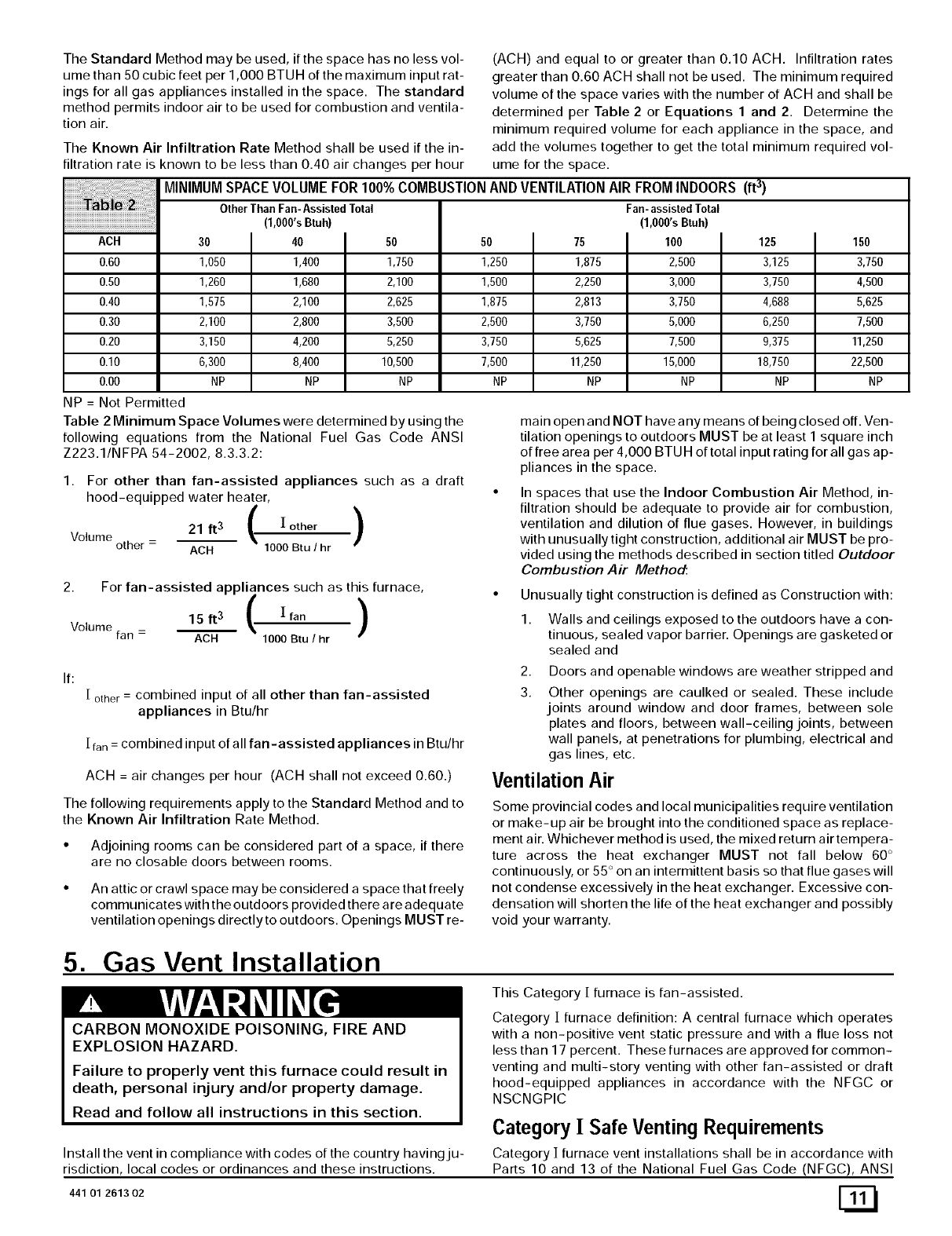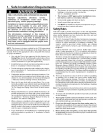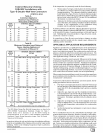
The Standard Method may be used, if the space has no less vol-
ume than 50 cubic feet per 1,000 BTUH of the maximum input rat-
ings for all gas appliances installed in the space. The standard
method permits indoor air to be used for combustion and ventila-
tion air.
The Known Air Infiltration Rate Method shall be used if the in-
filtration rate is known to be less than 0.40 air changes per hour
MINIMUMSPACEVOLUMEFOR100%COMBUSTION
OtherThanFan-AssistedTotal
.............................................................. (1,OOO'sBtuh)
(ACH) and equal to or greater than 0.10 ACH. Infiltration rates
greater than 0.60 ACH shall not be used. The minimum required
volume of the space varies with the number of ACH and shall be
determined per Table 2 or Equations 1 and 2. Determine the
minimum required volume for each appliance in the space, and
add the volumes together to get the total minimum required vol-
ume for the space.
ANDVENTILATIONAIRFROMINDOORS(ft 3)
Fan-assistedTotal
(1,000'sBtuh)
ACH
0.60
0.50
0.40
0.30
0.20
0.10
0.00
30
1,050
1,260
1,575
2,100
3,150
6,300
NP
40
1,400
1,680
2,100
2,800
4,200
8,400
NP
50
1,750
2,100
2,625
3,500
5,250
10,500
NP
50
1,250
1,500
1,875
2,500
3,750
7,500
NP
75 I
1,875
2,250
2,813
3,750
5,625
11,250
NP
100
2,500
3,000
3,750
5,000
7,500
15,000
NP
125 I 180
3,125 3,750
3,750 4,500
4,688 5,625
6,250 7,500
9,375 11,250
18250 22,500
NP NP
NP = Not Permitted
Table 2 Minimum Space Volumes were determined by using the
following equations from the National Fuel Gas Code ANSI
Z223.1/NFPA 54-2002, 8.3.3.2:
1. For other than fan-assisted appliances such as a draft
hood-equipped water heater,
21 ft3 ( I other )
Volume other = ACH 1000 Btu / hr
2. For fan-assisted appliances such as this furnace,
15ft3 ( Iran )
Volume fan = ACH 1000Btu / hr
main open and NOT have any means of being closed off. Ven-
tilation openings to outdoors MUST be at least 1 square inch
of free area per 4,000 BTUH of total input rating for all gas ap-
pliances in the space.
In spaces that use the Indoor Combustion Air Method, in-
filtration should be adequate to provide air for combustion,
ventilation and dilution of flue gases. However, in buildings
with unusually tight construction, additional air MUST be pro-
vided using the methods described in section titled Outdoor
Combustion Air Method:
Unusually tight construction is defined as Construction with:
1. Walls and ceilings exposed to the outdoors have a con-
tinuous, sealed vapor barrier. Openings are gasketed or
sealed and
If:
[ other= combined input of all other than fan-assisted
appliances in Btu/hr
[fan = combined input of all fan-assisted appliances in Btu/hr
ACH = air changes per hour (ACH shall not exceed 0.60.)
The following requirements apply to the Standard Method and to
the Known Air Infiltration Rate Method.
• Adjoining rooms can be considered part of a space, if there
are no closable doors between rooms.
• An attic or crawl space may be considered a space that freely
communicates with the outdoors provided there are adequate
ventilation openings directly to outdoors. Openings MUST re-
2. Doors and openable windows are weather stripped and
3. Other openings are caulked or sealed. These include
joints around window and door frames, between sole
plates and floors, between wall-ceiling joints, between
wall panels, at penetrations for plumbing, electrical and
gas lines, etc.
Ventilation Air
Some provincial codes and local municipalities require ventilation
or make-up air be brought into the conditioned space as replace-
ment air. Whichever method is used, the mixed return air tempera-
ture across the heat exchanger MUST not fall below 60 °
continuously, or 55 ° on an intermittent basis so that flue gases will
not condense excessively in the heat exchanger. Excessive con-
densation will shorten the life of the heat exchanger and possibly
void your warranty.
5. Gas Vent Installation
CARBON MONOXIDE POISONING, FIRE AND
EXPLOSION HAZARD.
Failure to properly vent this furnace could result in
death, personal injury and/or property damage.
Read and follow all instructions in this section.
Install the vent in compliance with codes of the country having ju-
risdiction, local codes or ordinances and these instructions.
441 O1 2613 02
This Category [ furnace is fan-assisted.
Category ] furnace definition: A central furnace which operates
with a non-positive vent static pressure and with a flue loss not
less than 17 percent. These furnaces are approved for common-
venting and multi-story venting with other fan-assisted or draft
hood-equipped appliances in accordance with the NFGC or
NSCNGPIC
Category I Safe Venting Requirements
Category ] furnace vent installations shall be in accordance with
Parts 10 and 13 of the National Fuel Gas Code (NFGC), ANSI


















